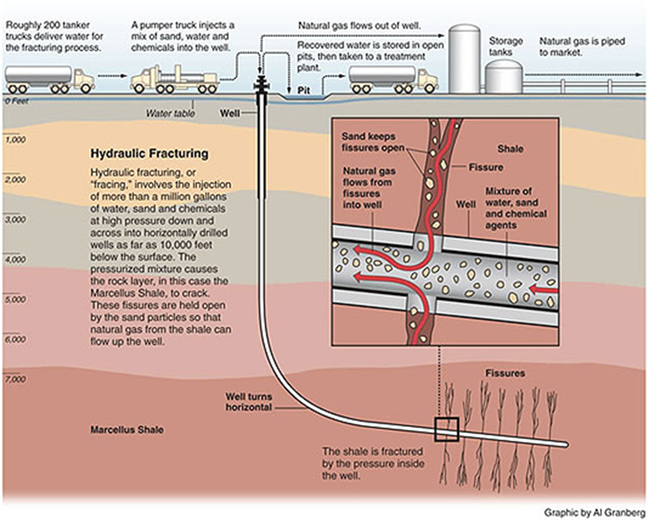Hydraulic Fracturing
What is Fracking?
Hydraulic fracturing has been in existence since 1947[i] where high pressure fluid is pumped into a well along certain veins to release petroleum and other hydrocarbons from the source rocks. The more modern technique of horizontal or “slickwater” fracking was first introduced in 1998[ii] in the Barnett Shale deposits in Texas. This horizontal method became much more economical and allowed for the new mining technique to be more widely used.
The purpose of hydraulic fracturing is to release natural gas trapped in shale formations. Shale is a fine grained sedimentary rock that is composed of a mix of clay minerals and is formed when riverbeds are exposed to high pressure compaction over millions of years[iii].
How is it Fracking done?
Simplified Steps In Hydraulic Fracturing[iv]
1. Water, sand and additives are pumped at high pressures down the wellbore.
2. The liquid goes through perforated sections of the wellbore and into the surrounding formation, fracturing the rock and injecting sand or proppants into the cracks to hold them open.
3. Experts continually monitor and gauge pressures, fluids and proppants, studying how the sand reacts when it hits the bottom of the wellbore, slowly increasing the density of sand to water as the fracturing progresses.
4. This process may be repeated multiple times in “stages” to reach maximum areas of the wellbore. When this is done, the wellbore is temporarily plugged between each stage to maintain the highest water pressure possible and get maximum fracturing results in the rock.
5. The fracturing plugs are drilled or removed from the wellbore and the well is tested for results.
6. The water pressure is reduced and fluids are carried up the wellbore for disposal or treatment and re-use.
How does Shale gas affect the energy outlook and market?
Shale gas plays a very important role in the energy market in the United States and Canada. The shale deposits in the US accounted for 1% of all US natural gas production in 2000 but by 2010, that number rose to 20%[v]. The Energy Information Administration in the US predicts that natural gas from shale deposits will account for 46% of the natural gas supply.
A study by the Baker Institute of Public Policy at Rice University concluded that increased shale gas production in the US and Canada could help prevent Russia and Persian Gulf countries from dictating higher prices for the gas they export to European countries[vi]
How will Shale Gas affect the Canadian Market?
We have seen a clear play by the major utilities in Canada to build a pipeline to connect southern Ontario’s storage areas with the Marcellus shale region on the US east coast. This pipeline named, the Nexus, pipeline has seen investment by both Spectra Energy (Union Gas) and Enbridge Inc. The intention is for this pipeline to start in 2014 with completion estimated in 2015[vii].
There is much more news on the Nexus or NTE pipeline but we will save that for another blog. The important information to consider here is that both Union and Enbridge will be attempting to diversify their energy portfolio, thereby bringing more competitively priced gas to Ontario and ideally reducing costs for the consumers.

Stay tuned for Hydraulic Fracturing part 2 where we look at the many environmental concerns of fracturing.

